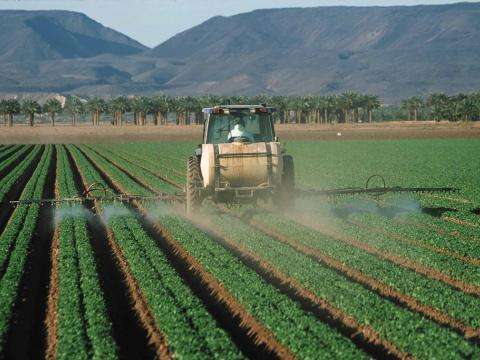Unprecedented levels of nitrogen could pose risks to Earth's environment

Human production of fixed nitrogen, used mostly to fertilize crops, now accounts for about half of the total fixed nitrogen added to the Earth both on land and in the oceans, according to a new study by researchers at North Carolina State University and Duke University.
Human production of this nitrogen is now five times higher than it was 60 years ago. This increase could pose as much of a danger to Earth's environment as the rapid increase in climate-warming atmospheric carbon dioxide, the scientists say.
"Earth has never seen this much fixed nitrogen," says William H. Schlesinger, James B. Duke Emeritus Professor of Biogeochemistry at Duke's Nicholas School of the Environment.
"It's a tremendous increase in the last half century, which is not what we were expecting to find," says William Battye, an air quality researcher at NC State who led the study
"While carbon has captured the attention of the world through climate change, we cannot ignore this issue," adds Viney Aneja, professor of marine, earth and atmospheric science at NC State. "Too much nitrogen can affect human health, reduce biodiversity and amplify global warming."
Too much nitrogen in the soil benefits a limited number of species that can outcompete native species, reducing biodiversity, Aneja notes. High levels of nitrogen in groundwater are associated with intestinal cancers and miscarriages, and can be fatal to infants. Excess nitrogen compounds in waterways and lakes can cause toxic algal blooms, killing off aquatic species and threatening human health.
One form of nitrogen gas, nitrous oxide, is also a potent greenhouse gas and can contribute to global warming. High levels of nitrous oxide in the atmosphere also degrade the atmospheric ozone layer, and nitric oxide can create dangerous ground-level ozone.
Humans have used nitrogen compounds as a fertilizer for millennia, but historically only used naturally fixed sources, like manure and guano. In the early 1900s, German chemists Fritz Haber and Carl Bosch discovered a process that converts atmospheric nitrogen to ammonia, allowing humans to produce nitrogen-based fertilizers on an industrial scale for the first time.
By 1960, more than 60 percent of farms in the United States reported using chemical fertilizer and the average nitrogen use was 17 pounds per acre.
In 2007, U.S. farms were using 82.5 pounds of nitrogen per acre on average, according to the U.S. Environmental Protection Agency.
To conduct their new study, the researchers combined historical data on fertilizer use in agriculture with recent estimates of nitrogen-fixation rates to analyze trends in human production of fixed nitrogen since the beginning of the 20th century. They then placed these trends in context with recent estimates of natural nitrogen fixation and denitrification rates on land and in water.
Their analysis revealed that human production of reactive nitrogen has increased almost five-fold in the last half-century.
"This rapid increase has removed any uncertainty about the importance of human-produced nitrogen on the overall nitrogen cycle," Schlesinger says..
Schlesinger, Battye and Aneja question if Earth's current denitrification process can continue to keep up with the human production of fixed nitrogen. Currently, the bacteria that drive this denitrification process seem to be keeping pace with the increased fixed nitrogen. But if the habitats where these bacteria thrive, such as marshes and wetlands, are not conserved, and the denitrification process breaks down, a major imbalance in the nitrogen cycle could occur.
This could lead to harmful algal blooms and dead zones in water bodies, higher costs for drinking water treatment, and an increased risk to public health from algal toxins in waterways.
Even if the denitrification process can keep up with increasing demand, there could still be negative atmospheric consequences of the excess nitrogen. Denitrification produces nitrous oxide, a potent greenhouse gas that is the third largest contributor to global warming after carbon dioxide and methane. Nitrous oxide has a greenhouse potential almost 300 times greater than carbon dioxide pound for pound and can last in the atmosphere for more than 100 years, according to the EPA. Nitrous oxide can also deplete the stratospheric ozone layer, Aneja says.
Nitric oxide, another byproduct of denitrification, can react with volatile organic compounds to produce ground-level ozone, which is harmful to humans and vegetation.
Human-caused climate change, a result of too much carbon dioxide in the atmosphere, could also intensify the amount of nitrogen in U.S. waterways. Climate change could cause more rainfall in some areas, which could result in more agriculture runoff that can contaminate local waterways, according to a recent study in the journal Science.
More information: William Battye et al. Is Nitrogen the Next Carbon?, Earth's Future (2017). DOI: 10.1002/2017EF000592
Journal information: Science
Provided by Duke University


















